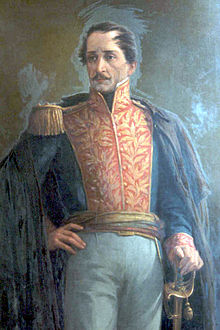
Back فرانثيسكو دي باولا سانتاندير Arabic فرانثيسكو دى پولا سانتاندير ARZ Francisco de Paula Santander AST Francisco de Paula Santander German Francisco de Paula Santander Esperanto Francisco de Paula Santander Spanish Francisco de Paula Santander Basque Francisco de Paula Santander Finnish Francisco de Paula Santander French Francisco de Paula Santander Scots/Gaelic
This article needs additional citations for verification. (August 2020) |
Francisco de Paula Santander | |
|---|---|
 Oil painting by Ricardo Acevedo Bernal. | |
| 1st President of the Republic of the New Granada | |
| In office October 7, 1832 – April 1, 1837 | |
| Vice President | José Ignacio de Márquez |
| Preceded by | Office Created |
| Succeeded by | José Ignacio de Márquez |
| 5th Vice President of the Gran Colombia | |
| In office November 3, 1821 – September 19, 1827 | |
| President | Simón Bolívar |
| Preceded by | José María del Castillo |
| Succeeded by | Domingo Caycedo (1830) |
| Personal details | |
| Born | Francisco José de Paula Santander y Omaña 2 April 1792 Villa del Rosario, Tunja Province, Viceroyalty of New Granada |
| Died | 6 March 1840 (aged 47) Santa Fe de Bogotá, Cundinamarca, Republic of New Granada |
| Nationality | Neogranadine |
| Political party | Federalist |
| Spouse | Sixta Pontón |
| Children | Francisco de Paula Jesús Bartolomé, Clementina Santander y Pontón, Sixta Tulia Santander y Pontón |
| Alma mater | Colegio Mayor de San Bartolomé Universidad santo Tomás |
| Awards | Cross of Boyacá Order of the Liberator Medal of the Liberators of Cundinamarca |
| Signature |  |
| Military service | |
| Allegiance |
|
| Branch/service | New Granadan Army (1810-1816) Liberator Army of New Granada and Venezuela (1816-1819) Gran Colombian Army (1819) |
| Years of service | 1810-1819 |
| Rank | General of Division |
| Battles/wars |
|
Francisco José de Paula Santander y Omaña (April 2, 1792 – May 6, 1840) was a Colombian military and political leader who served as Vice-President of Gran Colombia between 1819 and 1826, and was later elected by Congress as the President of the Republic of New Granada between 1832 and 1837. Santander played a pivotal role in the Colombian War of Independence being one of the main leaders of the Patriot forces and helped lead the Patriot Army alongside Simon Bolivar to victory. He's often credited with creating the legal foundations for democracy in Colombia, as well as creating the country's first system of public education. For these reasons he is considered a National Hero in Colombia and has thus commonly been known as "The Man of the Laws" ("El Hombre de las Leyes") as well as the "Organizer of Victory" ("El Organizador de la Victoria").[1]
Francisco de Paula Santander was born into a wealthy criollo family in Villa del Rosario, in the Viceroyalty of New Granada and spent most of his formative years there. In 1805 he left his home to continue his education in the Viceregal capital of Santa Fe de Bogotá, while finishing his studies on July 20, 1810 he joined in the revolutionary fervor that would be movement for New Granadan Independence. At the age of 18 Santander abandoned his studies to begin his military career fighting for the Patriot cause against the Royalists initially with the Centralists but switched sides and became an officer in the army of the Federalist United Provinces of New Granada.
In 1813 he would be wounded and captured during the civil war between the Federalists and the Centralists, but was released to serve under Manuel del Castillo y Rada and Simon Bolivar in the defense of the Cucuta Valley from the Royalists. For the next 3 years Santander defended the valley from Royalist Incursion until he was defeated at the Battle of Cachiri during the Spanish Reconquest of New Granada. With the collapse of the first republic, he fled to the Casanare Province and joined forces with Venezuelan Patriot forces there first under the command of Jose Antonio Paez, and then joined Bolivar's forces in Guayana in 1817. Under the command of Bolivar during the 1819 Campaign to Liberate New Granada, Santander led his troops valiantly at the battles of Paya, Gameza, Vargas Swamp, and at Boyaca liberating his homeland from Spanish Rule.
With the creation of Gran Colombia in December of 1819, Santander was initially chosen as Vice-President of Cundinamarca, in 1821 at the congress of Cúcuta he was elected as Vice-President of Gran Colombia with Bolivar as President. For the next 6 years, with Bolivar away on campaign, Santander became acting president of the new nation, using his administrative skills to create the foundations for the new republic. In 1827 political differences between him and Bolivar led to a rupture in their relationship, culminating in 1828 when Bolivar accused of him of having masterminded a plot to assassinate him. While no evidence was ever found to corroborate this, Santander was sentenced to the death however this punishment was changed and Santander was instead stripped of his titles and positions and sent into exile where he would spend next 4 years in Europe and in the United States. After the dissolution of Gran Colombia, in 1832 the newly established congress of the Republic of New Granada elected him as President where he served his term from 1832 to 1837. After the end of his presidency he was elected as a representative for Bogotá in the chamber of representatives, however his health began to rapidly decline resulting in his death on May 6 1840.
- ^ Arismendi Posada, Ignacio; Gobernantes Colombianos; trans. Colombian Presidents; Interprint Editors Ltd.; Italgraf; Segunda Edición; Page 21; Bogotá, Colombia; 1983